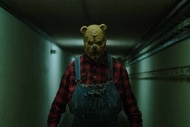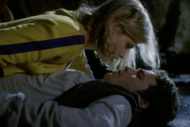How Sansa Stark became the queen of our hearts

The early chapters of Game of Thrones are filled with major moments that would define the series as a whole: the death of Jon Arryn, the discovery of the Lannister siblings by Bran Stark, the marriage of Daenerys Targaryen to Khal Drogo. But one of the most significant beginnings in the story happens when the character it concerns has no agency in it. When Robert Baratheon arrives in Winterfell to offer the Hand of the King duties to Ned Stark, the two men make an agreement betrothing Sansa Stark to Joffrey, the crown prince. In doing so, they set into action the most intact throughline of the entire televised version of the story.
Sansa's journey was almost as fraught off-screen as it was on. Early on in the series, Sansa was frequently reviled by the audience. In the way teenage girl characters often are, every mistake she made was viciously scrutinized — no matter how narratively supported or sound within the context of events, no matter how much she directly suffered as a result of them. But outside of those typical sources of criticism, her reception was hot and cold among the sorts of fans who typically line up to champion female characters in genre. Being a Sansa stan from the beginning, I reached out to other fans of the series and found a range of initial reactions, from repulsion to kinship.
"I hated her in Season 1. Going back, I question why," says Rachel Tibbits, a longtime fan of the show from California. "Why did I hate her? Because she was innocent, because she was romantic, because she believed in the dream her parents wove for her?" Likewise, Bonnie Miller, a fan from Indiana, couldn't connect with Sansa at first either: "In the early seasons, she was a spoiled little girl, wanting to be the princess of her own story. I didn't like her at all."
"I loved Sansa initially almost as a reaction to her haters. It seemed like the fandom was forcing this choice between Sansa and Arya, and Arya was the 'right" choice,'" says Kelly Anneken, a comedian and podcaster from San Francisco.
"I always related to Sansa because she’s the seamstress, like me," says geeky couture designer Catherine Elhoffer, who was so inspired by the fashions on the show that she created a whole line. "And I was so desperate for a boyfriend as a teen I could see how she was blinded by Joffrey for a while. But then after all her abuse and torture, it was hard for me to root for her ... because her story was just so dark and rough. I wanted her to be safe and happy but didn’t know how she could ever get there."Elhoffer touches on a point often lost among some of Sansa's fiercest critics: Sansa is pretty much a child when the story begins, and even what she has in age has been lost due to a sheltered upbringing. She’s never been quite at home in the North; she doesn’t take to its harshness the way that her sister Arya or her brothers do. You’d never find her climbing the walls around the castle of Winterfell like Bran. When they say “Oh sweet summer child,” they could easily be speaking to the Sansa Stark we meet in Season 1, Episode 1. She’s a little bit spoiled, being the daughter of a lord, but it’s spoilage that comes at a cost. Like Cersei Lannister before her, she’s been told her whole life that her entire worth in the world is to be strategically married off.And so Sansa rides south to King’s Landing with her father, possibly never to return home, and certainly not with the name Stark. She was filled with the fantasy of marrying the prince and becoming a queen, the highest mark for what she’s been taught is her role in life. As we know, though, “the night is dark and full of terrors,” and her journey is much harsher than the climates of Winterfell. In the course of the next eight seasons, Sansa is torn down, she’s abused, she’s raped. Over and over again, she’s pushed to the breaking point.
Despite all this, Sansa doesn’t break; instead, she learns. She survives by studying her enemies. She uses their strengths against them. She doesn’t just feed Ramsay Bolton to his own dogs, she uses his hubris to get him to expose his army in battle before the Vale rides in. She doesn’t just have Littlefinger arrested, she turns his machinations against him, exposing him in public so he has no means of wriggling his way out of another net. When the ash is cleared and when the story is done, she sits on a throne — her throne, in her home in Winterfell as Queen in the North. She is no longer some prize for a highborn young man to claim; she’s adapted to the harshness of the world, thriving in it.
Hana Michels, a Los Angeles writer, sees it even more distinctly. "She's the first character I've seen on TV who becomes a new person after PTSD. I've seen people get stronger or weaker, etc. But that's not all of what happens. Your brain literally changes. You become a different person."
It’s the most fitting ending in the series. It’s not just that she rode south to find her crown and instead found it right where she started. Thematically, Sansa has so many parallels with the North. The fate of both begins at the start of Game of Thrones with a handshake between two men who won’t be around to see it play out. The deaths of Robert Baratheon and Ned Stark knock both land and Lady off their paths, and as the series progresses we see them both dance along the precipice of freedom only to be pulled back time and time again. Their freedom is stolen in shady deals and the manipulation of cruel men, such as Tywin Lannister, Joffrey Baratheon, Littlefinger, and the Boltons. It is naively given away by good men unable to see past their own honor or sense of duty, like Ned Stark and Jon Snow.In the end, Sansa is the rightful Queen in the North, because she’s the one with the vision to see that unless she advocates for it, all their struggles will have been for nothing. It’s Sansa who wrangles the army of the Vale to seize the land back from Ramsay Bolton. It’s Sansa who bluntly asks the Dragon Queen what happens to the North when the war is done. She believes in the well-earned independence of the North so fiercely that she declares it during Bran’s coronation even before she knows that it will be her, not Jon Snow, who returns to rule it.
It's a personal journey that connected with lots of folks that I spoke to, regardless of how they felt about Sansa in the beginning. "She becomes pragmatic without becoming brutal, a realist but not a pessimist. Patient and judicious, but not hesitant," says Tibbits. "And that she is still feminine, that strength and a backbone of iron don't have a gender and don't have to come with a rejection of beauty."
"She had a [real] rough road but she traversed it, plus she makes sick gowns. So she’s the designer queen I always wanted her to be," Elhoffer concludes.
None may have summed it up better than Kate Anne from Los Angeles: "Sansa was a bitch starting out but then she became THAT BITCH by the end and I’m really here for that character arc."
The North kneels to Sansa Stark, as we all should — not out of subjugation but out of respect. She’s the Queen in the North, and she’s the Queen in our hearts. Long may she reign.
The views and opinions expressed in this article are the author's, and do not necessarily reflect those of SYFY WIRE, SYFY, or NBC Universal.































